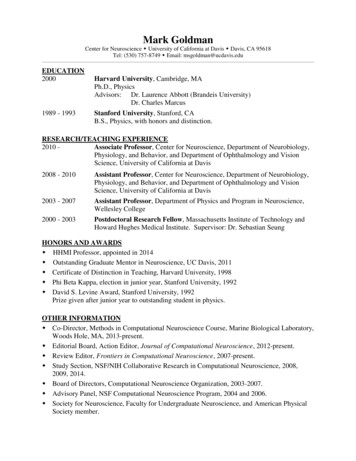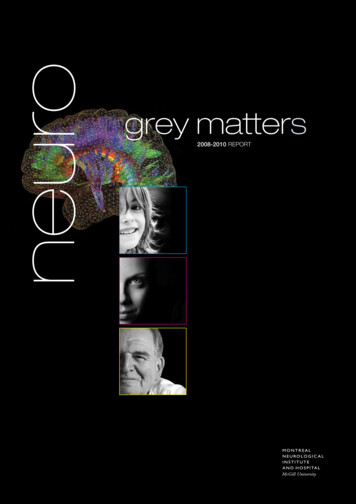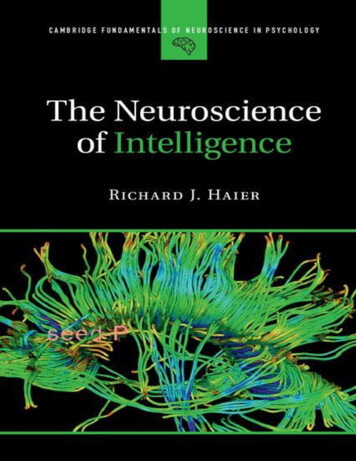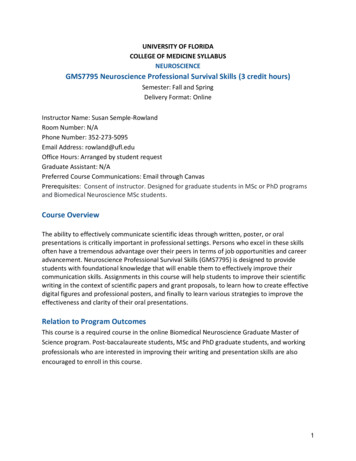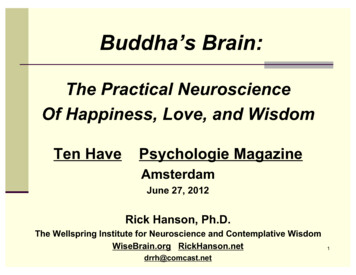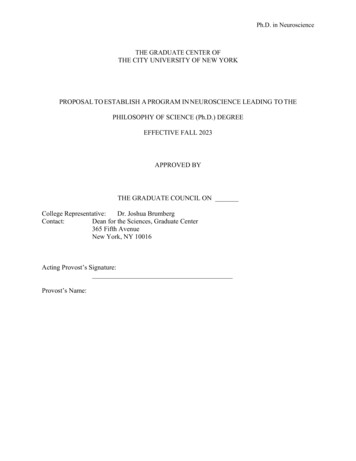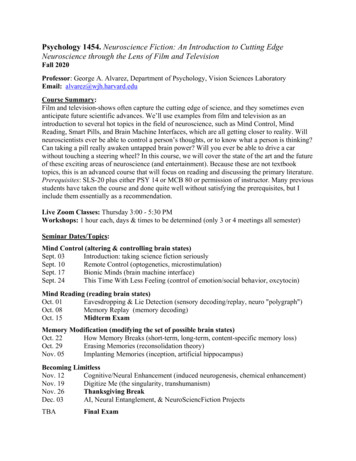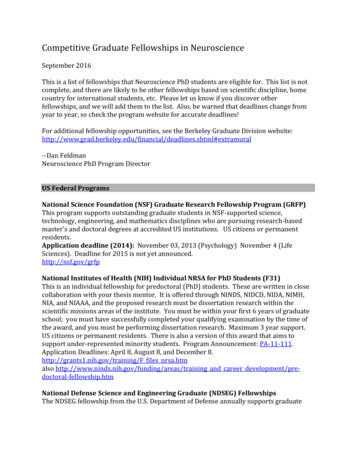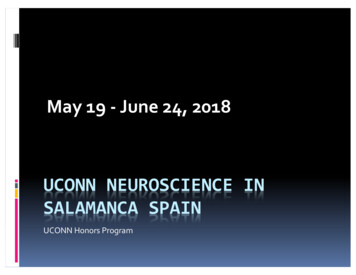
Transcription
Annenberg LearnerCourse GuideNeuroscience & the Classroom:Making ConnectionsA multimedia course for educators examining exciting developmentsin the field of neuroscience, and how new understandings about thebrain and learning can transform classroom practice.Produced by the Harvard-Smithsonian Center for Astrophysics
Neuroscience & the Classroon: Making Connectionsis produced by the Harvard-Smithsonian Center for Astrophysics 2011 Annenberg FoundationAll rights reserved.ISBN: 1-57680-893-9Funding forNeuroscience & the Classroon: Making Connectionsis provided by Annenberg LearnerAnnenberg Learner (a unit of the Annenberg Foundation) advances excellent teachingby funding and distributing multimedia educational resources (video, print, and Webbased) to improve teaching methods and subject-matter expertise. Resources aredistributed to schools and noncommercial community agencies, as well as collegesand universities, for workshops, institutes, and course use. Annenberg Learner makesits entire video collection available via broadband through www.learner.org. This Website also houses interactive activities, downloadable guides, and resources coordinatedwith each video series. To purchase video series and guides or learn more about othercourses and workshops contact us by phone or email or visit us on the Web.1-800-LEARNER order@learner.orgwww.learner.org
Table of ContentsCourse Overview.1Introduction: The Art and Science of Teaching.9Unit 1: Different Brains.11Unit 2: The Unity of Emotion, Thinking, and Learning.15Unit 3: Seeing Others from the Self.19Unit 4: Different Learners, Different Minds.23Unit 5: Building New Neural Networks.27Unit 6: Implications for Schools.31Conclusion: A Community of Educators .35i
ii
Neuroscience & the Classroom:Making ConnectionsCourse OverviewWelcome to Neuroscience & the Classroom: Making Connections. Thiscourse provides insight into some of the current research from cognitive scienceand neuroscience about how the brain learns. The major themes include the deepconnection among emotion, thinking, learning, and memory; the huge range ofindividual cognitive strengths and weaknesses that determine how we perceive andunderstand the world and solve the problems it presents us; and the dynamic process ofbuilding new skills and knowledge. The course invites you to examine the implicationsof these insights for schools and all aspects of the learning environments we create forour children—teaching, assessment, homework, student course loads, and graduationrequirements. It is not a course that offers easy answers or proposes teaching methodsthat can be universally applied. Rather, it provides new lenses through which to viewthe teaching and learning challenges you face and invites you to discover your ownanswers to your own questions.Course goals To foster an understanding of the unity of emotion and thinking and learning.To help educators connect brain research to classroom practice and schooldesigns. To illustrate the benefits of collaboration between researchers and teachers sothat research informs what happens in the classroom, and what happens in theclassroom informs research. To recognize and strengthen two roles of the teacher:1. Teacher as designer who creates the context for learning (environment,lessons) and who is able to take the perspective of learners.2. Teacher as researcher who treats student responses as data that revealthe effectiveness of lessons and that provide information for the next stepin the learning process.The greatest benefit of this course is that, instead of providing simple answers,“tricks,” or teacher-proof lesson plans, it treats you as a professional capable of findingyour own answers to the specific teaching challenges you face in your particularcircumstances. The course focuses on how learners learn and invites you to considerhow teachers teach. As a result, you will become more skilled at inventing teachingCourse Overview1Neuroscience & the Classroom
Thinking big, starting smallstrategies to improve the learning of your students.Along the way, the course offers you an important opportunity to revisit theexperience of being a learner. It will remind you of the ways in which your studentsstruggle with new material. In the language we use in this course, you will be “buildingnew neural networks” for understanding and for applying ideas and principles thatemerge from the research you study. To get the most from this experience (and fromthe course), we urge you to become conscious of your own learning—the struggles, themisunderstandings, the moments when ideas gel, the need to repeatedly revisit a newidea, your emotional responses, the conditions under which you do your best learning,the effort required—the whole messy, non-linear process. To this end, you may find ituseful to keep a journal of your learning: thoughts, feelings, observations, and insights.Thinking big, starting smallThe course has two main goals: To provide new insights into learning based on research. To stimulate your thinking on how to connect your teaching and lessons learnedto these insights.Some of the ideas in the course may challenge your current beliefs about learningand teaching. Many of the ideas may reinforce your beliefs, especially by makingyou conscious of feelings you have had about learning as a result of your years ofexperience as both a learner and a teacher. Either way, you will be filled with ideas, andyou may feel a desire to start changing and fixing things right away. You may even feelobligated to become an agent of change. We can offer only one bit of advice: relax.Change takes time, and most teachers don’t have a lot of that. The scope of whatyou can change also depends on how much authority or responsibility you have. Anexperienced division head may be able to implement new ideas more quickly andwith wider impact than can a new teacher. You can only do what you can do. What’simportant is that you start somewhere.Nick and Martha, the two teachers in Unit 6 (Sections 3, 5), didn’t start asrevolutionaries. Nick began with an idea that he wanted to give more choice to thestudents in his English class; he was looking for a way for his students to feel connectedto literature. Martha started with an idea about how to reduce the fear of and focuson grades in her history classroom. Other teachers begin with even smaller changes,though they often feel very big to the them. One decides that he is going to stoplecturing and let his students talk more, and find out what they think before telling themwhat he thinks. Another decides to spend more time getting to know her students aspeople, creating emotional connections on a personal level. One thing leads to another,and slowly these teachers influence other teachers or, eventually, become leaders—Neuroscience & the Classroom2Course Overview
The course guidedepartment chairs, division heads, principals—and these small changes spread. All thatmatters is that you continue to think, imagine, invent, and experiment.The course guideThe guide provides exercises to stimulate your thinking and to help you build newneural networks for the ideas presented in the course. The exercises focus on thespecific ideas contained in each unit, and run the gamut from a focus on personalexploration to classroom interventions to systemic change.You should find yourselfgoing back and forth from the unit to the exercises, with excursions into some ofthe additional material available in the course. These include video illustration orexplanation, sidebars of related information, and links to relevant articles that alsocontain bibliographies suggesting further possible readings.Although you can certainly take this course alone, you might find value in goingthrough it either with colleagues (at your school or online) or in a more formal class witha leader or facilitator. You or your facilitator can select exercises from those suggestedin this Guide, and can invent some of your own based on questions, issues, or problemsthat affect your school or classroom. Combining written responses, discussions withcolleagues, and personal reflection about what you are learning will be most helpful.A note to facilitators and those taking the course for creditYou can take the course for credit in one of three ways: on your own, with acolleague (at your school or online), or as part of a larger group with a facilitator.The course can be taken for two graduate education credits through Colorado StateUniversity. For more information on receiving graduate credit for this course, go tolearner.org/workshops/graduate credit.html.It is the facilitator’s job to create the shape of the course by selecting the specificadditional readings and the exercises—balancing the apparent needs of the group withthe time requirements for earning the credits. If you are taking the course alone or witha partner for credit, your job will be to take on the facilitator’s role—creating the shape ofthe course by selecting from the course materials to meet your educational goals and tomeet the requirements for earning the credits.Reading the text and sidebars in each unit, including the Introduction andConclusion, should take about two hours per unit. This includes watching the videos andthinking about what you’ve read. Most of the supplemental articles will also take aboutan hour to read, and each one of the assignments for each section of the text can bedone in some fashion in an hour, except where otherwise noted. However, as teachersyou know that learning new material tends to demand more time and thought than aninitial reading takes, and you know that everyone works differently and requires differentamounts of time to work through problems or assimilate new ideas. So rather thanCourse Overview3Neuroscience & the Classroom
A note on the approach to preparation between unitsmoving through the course and the exercises to the rhythm of a clock, we suggest thatyou move to the more irregular pace of your personal learning process, guided by itsinevitable cycles of progress and regression. Ultimately, the most important outcome isthat you learn the concepts sufficiently so that you can take them back to your schoolsand put them into practice. To achieve this goal, you will spend more than the minimumhours specified to receive credit.A note on the approach to preparation between unitsIn courses like this, you get a lot of information, but assimilating that information—beginning to really understand and internalize it so that you can use it—tends to bevery difficult. Information comes to you; some of it seems exciting and provocative andstimulates all sorts of ideas. But pursuing those ideas is like chasing rabbits through afield: a glimpse here, a feeling that you’ve almost caught one, and then they disappear.As you go through each unit, it is essential to think about the ideas—to see ifyou can put them into your own words or apply them and discover where you stillhave questions. Each of us assimilates information differently, so between units weencourage you to design your own homework. (Those taking the course for credit willneed to discuss this suggestion with the facilitator.) Decide what you need in order tobegin the process of internalizing and applying the ideas around which the workshop isconstructed. Ask yourself, “What would help me? What do I need now?”Here are some possible homework avenues and some resources that are availableto you: Review: Read an essay that develops some of the ideas from the unit thatyou just studied. In each unit, you will find supplemental articles for furtherreading. (For the complete bibliography, please go to the Resources section ofthe website.) View one or more of the videos in a unit and think about how itillustrates the principles in that unit, or simply reread the unit. Preview: Read an article that touches on ideas that will be presented in thenext unit. Some people like to preview ideas, so you might select one of thesupplemental articles contained in the upcoming unit. Or you can read theupcoming unit before it is assigned, watch the accompanying videos, and jotdown some ideas. Then, reread the unit and think more deeply about the ideasyou wrote down. In this method, the rereading is important. Discuss: Get together with one or two people to discuss the ideas from theunit just completed: “Here’s what I think I understand; here are the questions Istill have.” If you are taking the course for credit, you can have these informaldiscussions before or after your full-group discussions. Record your thoughts: Sit alone and write about the ideas from a unit—putNeuroscience & the Classroom4Course Overview
Getting startedthem in your own words, look at their implications, see what questions stillarise. Especially useful might be to explore how a new concept challenges,changes, or supports an idea or belief you already have. For example, youmight productively examine your initial thinking about the connection betweenemotion and learning in light of new ideas presented in the course. Apply the ideas: Give yourself a practical exercise such as looking at theimplications of a specific idea for some aspect of school (homework, a lessonplan, a teaching method, grading, memorization, etc.). Try to link a specific ideaor quotation from the unit to the particular implication. (In the supplementalarticles, you also will find some essays that are written by teachers that focuson practical implications.) Combine exercises: Any of these suggestions can be combined. For example,while writing in your journal, you might find yourself wanting to reread a sectionof a unit or replay a video, or you might want to read a related supplementalarticle or start a discussion with a colleague. Then, you might want to return toyour writing.For those who like more direction for homework possibilities between units, we offersome reading suggestions from the collection of supplemental articles. And, there areexercises later in this guide under the heading of each unit.Getting started: Your first assignments for the coursePrior to studying the course text or viewing the videos, we ask you to read a shortessay and do some writing assignments. These first assignments lay the foundationfor the course, for you will return to this work both as you progress through some ofthe units and at the end of the course. While you can go through the course materialshowever you wish, the course is designed to take you through an introduction, six units,and a conclusion. Between each of these parts, there are suggested readings andexercises to help you build an understanding of the concepts over time.Assignment 1: Write about the connection between emotion, thinking, and learning.Send what you have written to the facilitator or share it with others who are takingthe course with you. (The facilitator can revisit these periodically during discussions.)Assignment 2: Read and discuss “Fostering Conceptual Change.”The purpose of this assignment is to begin to make you aware of your own cognitiveand emotional processes. You should read the article to explore the extent to whichit applies to you—the degree of difficulty you experience when making conceptualchange.This course may challenge some of your strongest beliefs about teaching andCourse Overview5Neuroscience & the Classroom
Getting startedlearning, and the essay may help to sensitize you to signs of resistance to new ideasand may help to provide some strategies for overcoming this resistance.As you proceed through the course, revisit the ideas in this essay and examine yourreactions to challenges to your beliefs about education. In addition to discussing thesethoughts with others who are taking the course with you, you might find it beneficial tobegin your course journal with these reactions and thoughts.Assignment 3: Write about a teaching or learning problem.Think of a specific teaching or learning problem you have encountered.The problemshould derive from something that you found difficult to help your students (if you area teacher) or colleagues (if you are an administrator) to learn or understand. Focus onthe essence of it, not a detailed retelling. Follow the models below to get an idea of thelength expected.1. Write a brief analysis of the problem: What do you think is the issue? Whatsolutions might you try?2. Send this assignment to the course facilitator or share it with your group orpartner. (The facilitator can revisit these periodically during discussions, andyou will be using this problem for the final assignment.)Here are a few examples: A teacher was focusing on teaching ninth graders how to write a coherentparagraph—a topic sentence followed by an illustration and explanationand then a concluding sentence. In class the teacher provided examples ofparagraphs, modeled the creation of a paragraph, and then led the classthrough the creation of a paragraph composed on the white board. This groupparagraph was successful. For homework, he asked each student to write aparagraph, and he was puzzled to find that most of the paragraphs he receivedreflected no understanding of how to write a paragraph. A second grade math teacher worked to help students to articulate theirmathematical reasoning. He wanted them to explain, “The problem said ‘twomore came,’ so I knew I needed to add,” but he got, “I knew 2 4 was 6.” In atwo-step problem, he was looking for, “I knew I needed to find the total beforeI could divide them all equally,” but he got, “I knew 13 3 was 16, and I knew16 divided in half was 8.” Or in a problem involving permutations, he wanted,“I found 4 combinations starting with the yellow shirt, so I knew there would be4 combinations with the green shirt and the orange shirt, and 3x4 is 12,” buthe often got, “I tried all the different combinations I could think of and got 9.”Even after introducing the notion of organizing data and demonstrating variouspossibilities, he found that many students didn’t internalize the importance ofNeuroscience & the Classroom6Course Overview
Unit exercises for thinking, writing, and discussionorganizing the data and approached a similar problem, a few weeks later, asrandomly as the first. A school administrator’s greatest challenge was figuring out how to motivateher faculty to incorporate more research-based strategies into their instructionin order to develop higher-level thinking skills in the students. Despite allher efforts—explaining the benefits of these ideas, providing articles for herteachers to read, sending specific teachers to workshops and conferences,providing in-service workshops, offering financial incentives—she could notteach them to effect the changes she hoped to see.Unit exercises for thinking, writing, and discussionAll assignments are meant to be done after you have read the unit text and watchedthe accompanying videos under which the assignments appear. For example, beforedoing the assignments listed under “Introduction,” read the Introduction in the coursetext, including the sidebar, and watch the videos.In approaching all exercises and discussions, it is important to be free from selfdefeating mindsets of “can’t,” such as “we could never do that in my school,” or “we triedthat and it didn’t work.” These exercises are intended to be explorations inviting you tolook at existing structures and practices through new lenses and imagining “What if?”and “Why not try?” Once you have a vision of what might be, there is always plenty ofopportunity to explore the obstacles and imagine how to deal with them.Course Overview7Neuroscience & the Classroom
Neuroscience & the Classroom8Course Overview
IntroductionThe Art and Science of TeachingMajor principles Effective research about learning results from researchers andteachers working in a dynamic partnership. Researchers provide insight into learning. Effective learning is supported by teachers who are reflective aboutthe relationship between their teaching and the students’ learning. Teachers use research to discover answers to their own questionsabout how to foster meaningful learning. What teachers think is easyfor learners may not be. Teachers must be wary of brain-based panaceas.Assignment 1: Take some time to think or write about three roles of a teacher: Designer who creates the context for learning (environment, lessons) and whois able to take the perspective of learners. Researcher who treats student responses as data that reveal the effectivenessof lessons and that provide information for the next step in the learning process. Member of a professional community who interacts with researchers.Discuss these roles by sharing illustrations of them from your own experiences orfrom ideas you have about how to put these roles into practice. For example, when andhow have you, or might you, take on the perspective of learners in your classroom? Canyou illustrate the benefits? How might you become a researcher in your classroom?What might you learn from viewing student responses as data (evidence of howstudents are approaching a problem or of the strategies they are using to solve it, asopposed to simple right or wrong answers)? How might you become more active in acommunity of educators?Assignment 2: Write about and discuss the extent to which your school and yourteaching are built on “knowing answers.”One important part of this course is the emphasis on moving away from a conceptof learning that is limited to knowing the answers. In the introduction (Section 3),Jason redesigned his class so that his students would think of themselves as problemdesigners (asking good questions) instead of problem-solvers (focusing on gettingIntroduction9Neuroscience & the Classroom
Assignments/Suggested Readingsanswers). And Sam (Introduction, Section 7), the young theater teacher, discovered thatcreating his own answers to teaching problems made him a better teacher than whenhe simply used answers that other teachers provided.Identify in your writing very specific evidence that illustrates your claims. What newinsights are you discovering about this approach to learning?Assignment 3: Write about and discuss the school-related topics that either reflect orconflict with the fundamental beliefs you have about learning.Look at the final list of school-related topics at the end of the Introduction: Motivation, attention, engagement, and memory. How different students perceive and solve problems. Learning differences and disabilities. Policy and practice issues involving all aspects of school (such as homework,grading, course loads, graduation requirements, etc.).Take some time to write about and discuss the ones that jump out at you, becausethe way they are manifested in your school seems either to reflect or to conflict withfundamental beliefs you have about learning. Be specific about both your beliefs andthe reflection or conflict you see.Suggested readings between the Introduction and Unit 1:Possible review:Ablin, J. “Learning as Problem Design Versus Problem Solving: Making theConnection Between Cognitive Neuroscience Research and Educational Practice.”Mind, Brain, and Education Vol. 2, Issue 2 (May, 2008): 52–54.McDevitt, T.M. and J.E. Ormrod. “Fostering Conceptual Change About ChildDevelopment in Prospective Teachers and Other College Students,” Child DevelopmentPerspectives, Vol. 2, Issue 2 (August, 2008): 85–91.Possible preview:Immordino-Yang, M.H. “A Tale of Two Cases: Lessons for Education from the Studyof Two Boys Living with Half Their Brains.” Mind, Brain, and Education Vol. 1, Issue 2(June, 2007): 66–83.Neuroscience & the Classroom10Introduction
Unit 1Different BrainsMajor principles All brains are different. One teaching style, one approach, and one design will not succeedwith all learners. Brain function relies on interconnected systems rather than onseparate modules or hemispheres. How we perceive the world and solve problems is determined by ourprofile of cognitive strengths and weaknesses, our experiences, ouremotional needs, and the sociocultural context. What teachers think is easy for learners may not be. Young brains are more plastic but less efficient.The major principles explored in Unit 1 suggest that schools and classrooms needto be as flexible as possible in working with the array of different perspectives andcognitive strengths students bring with them. For learners with various profiles to besuccessful, teachers must find flexible ways of presenting lessons or of being opento flexible ways in which students might demonstrate their understanding. Providingthis flexibility allows students different entry points to the lesson. For example, Nico’sapproach to the problem of recognizing and producing tonal meaning in conversationwas to treat the problem as pseudogrammatical, while Brooke’s approach was heavilyemotional. It is the same problem, but with different entry strategies—depending on thecognitive strengths of the two boys.As you go through the suggested exercises below, keep the major principles of theunit in mind.Assignment 1: Write about and discuss the various aspects of your classes and of yourschool that allow for flexibility.Recall the story of Nico and Brooke (Unit 1, Section 4)—how their teachers neededto adapt to the boys rather than expect the boys to adapt to a preset curriculum.Although these teachers were confronted with an extreme demand for differentiatedinstruction, their experience suggests that teachers might profit from assuming thatUnit 111Neuroscience & the Classroom
Assignmentseveryone’s brain is a bit different.Look at various aspects of your classes and of your school (for example, grading,homework, graduation requirements, daily schedule, assessment, etc.). Which onesallow for flexibility? Which ones do not? How might the latter be made more flexible?Can you think of any students who might learn more as a result of this flexibility?Assignment 2: Analyze a case study.Recall the story of Brooke and the expectation that, given his neuropsychologicalprofile, he would find it easy to reproduce tonal sounds using nonsense syllables (“nana”) (Unit 1, Section 6).Case study: Stan is in Ms. J’s English class and writes good essays about issueslike teen drug use and democracy. He has an unusual knack for using good personalexamples and organizing persuasive arguments. Many of his classmates strugglewith organization, so Ms. J came up with the idea of simplifying the task by strippingit down to what she saw as its basics. She disassembled good paragraphs (takenfrom professional writers), listed the sentences out of order, and asked the students toreassemble the paragraphs. She assumed Stan would be the best in the class at thisexercise and was surprised to find he was the worst.Write down the answers to the following questions:1. What might explain Stan’s poor performance?2. In thinking about this case, what is required of a student to be able to do Ms. J’sexercise?3. How might different people approach this task?Assignment 3: Select a piece of work from two different students doing the sameassignment—a homework assignment, or a test, or a project. One piece should be froma student who did poorly (received a bad grade but appeared to try), and one should befrom a student who did well on the same assignment.Answer the following questions:1. Looking at this work as a source of data, what do you think it reveals about howthe students approached the problem?2. What knowledge or understanding did each student possess?3. What strategies were used?4. Where did one student seem to move away from your expectations, and arethere any clues as to why the student went in this direction?5. Did this student seem to share your understanding of the problem orassignment? Why or why not? As you consider this problem, think about not justNeuroscience & the Classroom12Unit 1
Assignments/Suggested readingsthe individual cognitive profiles students bring to problems, but also the plasticityand relative inefficiency of a child’s brain.6. Finally, can you imagine a way that the less successful approach to theassignment might lead to an interesting solution that you might not haveconsidered? If you struggle with this exercise, try examining the selectedstudents’ work with a colleague or two.Assignment 4: Interview students to gain additional insights.As an additional layer to the previous exercise, try interviewing both students abouttheir work to attempt to gain more insight into each one’s thought process, knowledge,perception of the problem, and strategies for solving it.Answer the following questions:1. Were your analyses of the work reinforced by how the students talked about it?2. Did you find anything surprising in the students’ answers that might help you tosee where each was coming from?Suggested readings between Unit 1 and Unit 2:Possible review:Immordino-Yang, M.H. “A Tale of Two Cases: Lessons for Education from the Studyof Two Boys Living with Half Their Brains.” Mind, Brain, and Education Vol. 1, Issue 2(June, 2007): 66–83.Possible preview:Immordino-Yang, M.H., and A. Damasio. “We Feel, Therefore We Learn: TheRelevance of Affective and Social Neuroscience to Education.” Mind, Brain, andEducation Vol. 1, Issue 1 (March, 2007): 3–10.Immordino-Yang, M.H., and F. Matthias. “Building Smart Students: A NeurosciencePerspective on the Role of Emotion and Skilled Intuition in Learning.” In D. A. Sousa(Ed.), The Future of Educational Neuroscience: Where We Are Now, and Where We’r
All that matters is that you continue to think, imagine, invent, and experiment. The course guide The guide provides exercises to stimulate your thinking and to help you build new neural networks for the ideas presented in the course. The exercises focus on the specific ideas contained in each unit, and run the gamut from a focus on personal


